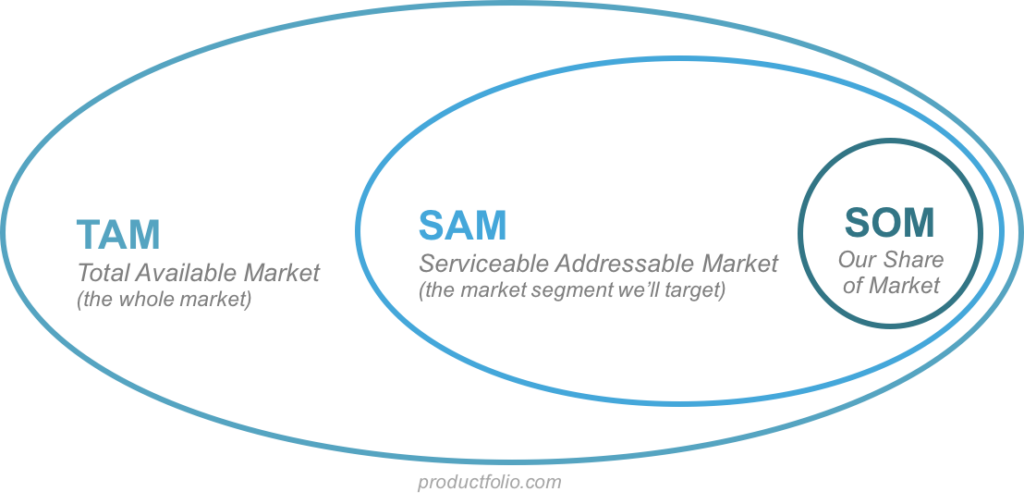What Are TAM, SAM, SOM?
TAM / SAM / SOM is a model for market sizing and can quickly provide a sense of the opportunity before making deep investments in pursuit of it. The model requires developing 3 graduated estimations of the market – the total available market (TAM), the part of that market that is serviceable with the solution you’re considering (SAM), and finally the share of market you anticipate you can capture (SOM).

Total Available Market (TAM)
TAM stands for Total Available Market. When developing a new product it’s important to start with an understanding of the entire market that may buy or use your product or service. Let’s say that you’re developing a website that’s going to sell cat food and cat toys. The total available market (TAM) would be the number of people around the world who have cats as pets. By looking at the Total Available Market (TAM), you’re assessing your revenue opportunity. It’s a metric that quantifies market potential.
Serviceable Available Market (SAM)
SAM stands for a Serviceable Available Market. In this step, which comes after TAM, you’ll be addressing how much of the Total Available Market (TAM) you can logistically service. Since we’ve decided that you’re developing a website that is All Things Cats (food, toys, etc…) you’ll need to now take into account the language that you’re website is in. If it’s only in English then your serviceable market is English speaking people who have access to the internet and that own cats. You’re now getting closer to what your true market potential will look like with your new website, All Things Cats.
Share of Market (SOM)
SOM stands for Serviceable Obtainable Market. This is the portion of the market that shows your likely outcome. In this stage, you will determine how much of the Serviceable Obtainable Market you can actually capture. As an example, your All Things Cats website is only in English as we determined with SAM, how many competitors are also in the English speaking market. Once you’ve determined market saturation, you’ll need to look at the price. Will you be able to match or beat their price. The reality is that you will only capture a fraction of the Serviceable Available Market (SAM) and it’s important to determine a realistic model of how much of that percentage you are likely to capture after launching your product.
Why does TAM/SAM/SOM matter?
The purpose of TAM/SAM/SOM is to validate that the opportunity is big enough to warrant the investment. The first target for your product should be to achieve your Serviceable Obtainable Market (SOM) goal. Once this has been achieved, you can now assess how you might capture more of the Service Available Market (SAM). You may, at this point, be able to cut out some of the competition by acquiring them or beating them on cost. If you’re going after the luxury market you may now have some exclusivity and hype that the market is vying for. Once your goal has been achieved in the Serviceable Available Market (SAM), you can can consider how to extend into the broader Total Available Market (TAM).
The example above is a similar model to what Amazon did with books. This business model could be put into practice for All Things Cats, and would be a way of obtaining the Total Available Market (TAM). If however, you are unable to achieve your goal in the Serviceable Obtainable Market (SOM) you will not be able to compete in the Serviceable Available Market (SAM) or the Total Available Market (TAM). It’s important to do one market subset at a time.
In conclusion, applying the TAM/SAM/SOM to new product opportunity evaluation is essential. All new products should have a clear understanding of a realistic and attainable goal so that you have a target to meet. This also provides insights into the market that the product will be entering into, which is important for a product to be successful.